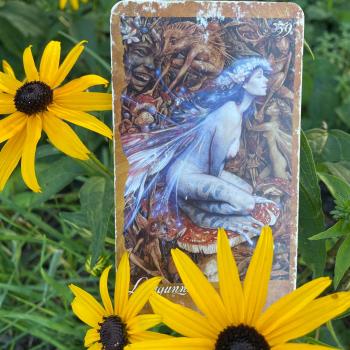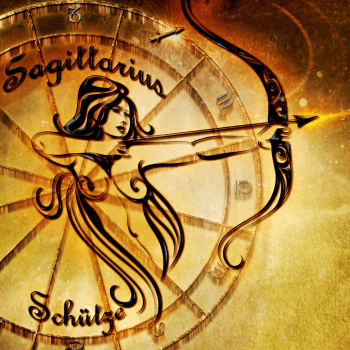“Before it happens, just a little adventure inward to see who is this fellow hiding behind the clothes, inside the skeleton; who is this person who is born, becomes a youth, falls in love and one day dies and nobody knows where he goes.… Just a little curiosity to inquire into one’s own being.” -Osho
When using the tarot to inquire into one’s own being, it’s necessary to be aware that the cards may present to you the self you would rather not see, what Jung referred to as the “shadow.” I do regular, personal shadow work with the cards as knowing myself is imperative to my path as a witch and to reading well for myself and for others. It’s also imperative for me to do the this work so that I am not an asshole.
In my experience, the cards that people fear when I turn them over are the cards that prominently present their shadow: Death, the Devil, and the Tower. Tonight I would like to look a little closer at these cards. I’m not interested in the historical definitions for these cards for the purpose of this post- by the way, a google search will assist you if you are interested in that. This is solely my view from my experience with the cards. And pictured is the Joie de Vivre Tarot by Paulina Cassidy, which is my favored deck and almost always the one I picture when I write about tarot.

With the number of cads out there who like to think they can predict a client’s death and find no ethical qualms in doing so (because they have no ethics) I understand the fear associated with this card. In reality, this card does not typically denote an actual, physical death in any given reading. I know Paulina’s art is adorably morbid here, but Death looks so sad. She’s too weak to move on her own, so her bat companion (a classic symbol of the shadow) lovingly carries her toward the promising star in the middle of the vortex. The bat is also symbolic of a guardian spirit or fetch, which every person has, who protects us in life and assists us in transitioning when it is time to die to this form. This can indicate, in a reading, spiritual assistance that is available in personal transformation.
We don’t know what’s on the other side of the vortex, we just know she’s heading there and she isn’t alone. She clings to the promise of life in one hand (the rose) while she looks back sorrowfully. The Rose has been picked, indicating limited time. She has wasted away to nothing. There is a sense of illness, but there is also the reality of moving forward, that this too, shall pass.
We’re seeing a dark night of the soul here. This is an important card because we all face these experiences. It may be uncomfortable to admit, but it is necessary to accept these experiences for what they are and to integrate the lessons learned from them. When this card shows up in a reading it validates your pain, your grief, your struggles, perhaps your illness as well. It validates that you are leaving something behind for something new. It shows you the universal truth that we can’t always know what’s in store for us on the other side of what we’re experiencing, but that having faith that it will be better than what was is a comfort in the process. Recognize that you are being validated, commended even, for releasing and moving forward, for braving grief, for embracing your shadow and this unhappy experience and letting it guide you toward the light.

The Devil is often a card people fear because of Christian mythos and connotations. In the sense that it is often a sign of vice and being controlled by something other than yourself, it does rather fit that imagery. But it’s not about the actual devil. It’s about very real human conditions. In Paulina’s tarot, the devil is a gleeful miscreant standing atop a treasure chest. He appears to be reveling in making the little marionette dance, but his hat has a face of total despair. He wears a cape from which dangle the heads of those who have lost themselves to him. He thinks he is in control but on his right foot there is a shackle chaining him to the treasure chest. The marionette is cutting its own strings, working on freeing itself from control of the mischievous devil. So, all in all, who is really in control?
One of the most prominent messages of this card is the message of addiction. This card is a wakeup call to check your motives and what truly drives you. The devil himself is operating under the illusion of control, thinking he is the master manipulator, but he himself is a slave. When we are unaware of what drives our actions, we are also slaves. We are slaves to our unconscious habits and processes. We are slaves to what we crave. He looks like he’s having a grand time but his hat (his soul) shows otherwise, so he is in deep denial of his problem. There is a spiritual neglect present with this card. Because he is not in control, truly, he is abusive and manipulative, and controlling toward others. This is a very real facet of human life experience. It may be uncomfortable to face these tendencies in ourselves (or in those we love), but if we want to live from a place of truth, to be healthy and happy, it is essential that we do so.
The marionette cutting its own strings is the message of hope within this card. Rarely will tarot point out a problem without offering a solution. The message of hope is a message of empowerment: taking matters into your own hands to free yourself of your self-destructive tendencies (whether the issues presented are yours or if you are codependent and on the receiving end). The first step, always, is admitting you have a problem whether the issue is addiction or other lifestyle patterns that are making your life hell. The message of hope is that you have a choice. Despite how it may appear, you are not a helpless victim. This card can be a symbol of a personal revolution if you’re willing to let it be so.

And, The Tower. In the deck I use it’s not quite so jolting as in other decks, though it is still quite serious. The top of the tower is cast off by some cracken-like creature that is taking it over, destroying it from the inside. The woman has been pitched out and is falling head-first toward the ground. Her facial expression is relatively stoic, perhaps she is experiencing some detachment or the acceptance of the total destruction of the tower. Butterflies, symbols of transformation, come to her rescue and keep her from total destruction. Their presence indicates a lesson learned.
This card is one we definitely don’t like to see, especially in readings about projects or relationships where we had very high expectations and a lot invested. However, this card very often serves as a warning that we are operating from a place of illusion or denial and the consequences of that are nigh. The Tower is the card that comes immediately after The Devil in the tarot. The Tower indicates what happens to us when we don’t heed the message of The Devil but instead pretend that we have no say or that there is nothing wrong with how we are living.
There is a lesson in rock-bottom here when we allow ego and selfishness to rule and refuse to face our dysfunction. There is no escaping it whether we want to face it or not. I feel I must note historical context for this card: it’s inspiration comes from the Tower of Babel. Pride goeth before the fall. The butterflies in this card are the message of hope despite the sudden and intense upheaval we are facing: it will bring about the necessary changes for us to set stronger foundations when we rebuild. There is treasure in this trash-heap of an experience. That treasure is the wisdom and capacity available to you to make better choices next time. All is not lost if you incorporate what you’ve learned into your decisions moving forward.
(Images in this post are from the Joie De Vivre Tarot by Paulina Cassidy, published by US Games).















